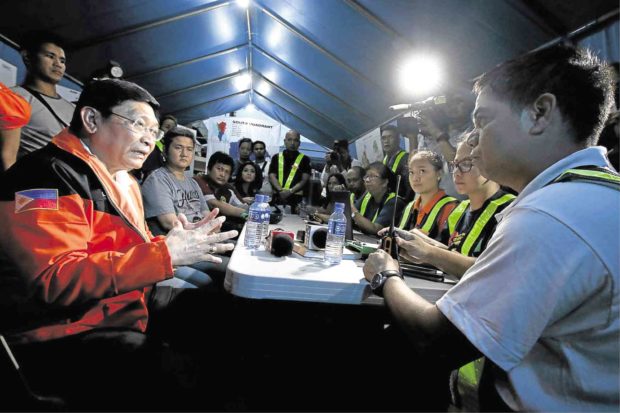Metro traffic part of ‘Shake Drill’ challenge

A rescue scenario plays out at LRT 2 Santolan depot on Friday, opening this year’s four-day Shake Drill.—LYN RILLON
Staging it on a “payday Friday” was part of the test.
The third annual “Shake Drill” kicked off on Friday with rescuers and volunteers simulating emergency scenarios in the aftermath of a major earthquake and testing whether they could act fast enough through the daily calamity that is Metro Manila traffic.
Metropolitan Manila Development Authority (MMDA) chair Danny Lim said the drill—which this year will be conducted for four days in different parts of the capital—factored in road congestion as one of the challenges facing responders.
“Many criticized us for doing this on a payday Friday, but we have to do this to simulate a worst-case scenario and to test our capability,” Lim told reporters. “We have to see how fast our response time is and how the various government agencies, the private sector and the local governments would react.”
For the Day One exercises, Lim cited the cooperation of motorists particularly along C5 Road, noting how they gave way to emergency vehicles.
Article continues after this advertisementThis allowed him and his party to reach the emergency operations center at Camp Bagong Diwa in Taguig from the MMDA headquarters in Makati in just 22 minutes.
Article continues after this advertisement
MMDA chair Danny Lim (left) confers with the emergency response team stationed at Villamor Air Base and responsible for Metro Manila’s southern quadrant.—RICHARD A. REYES
Traffic aides tested, too
Mon Santiago, the head of the MMDA’s Metro Manila Crisis Monitoring and Management Center, said the skills of traffic enforcers were also tested by the drill being held on a payday, where the afternoon traffic tends to be heavier.
The drill officially started at 4 p.m., with the exercise sites being hit by a power outage and a disruption in cell phone communications.
At participating companies, employees received emergency alerts through text messages telling them to “duck-cover-hold!” and were made to file out of buildings in orderly fashion.
Though many expected traffic to become a nightmare that afternoon, the MMDA said road conditions near the drills were not as heavy as anticipated.
This year’s quake drill will run until Monday for the MMDA to simulate various scenarios and assess how neighboring provinces such as Rizal, Batangas, Cavite and Laguna could help those in the capital in the event of killer temblor emanating from the 100-kilometer West Valley Fault.
Original plan
The Inquirer learned that the MMDA initially planned the drill to remain “unannounced” to see more accurately how the public and emergency responders would react. But the idea was dropped for fear of causing widespread panic.
Renato Solidum, head of the Philippine Institute of Volcanology and Seismology, appealed to the public to take such exercises seriously, as he noted the recent quakes hitting the Visayas.
Manny Gonzales, head of the MMDA oversight committee on public safety, said that for this year they were able to improve the communication among the concerned agencies, enabling their teams in the four Metro Manila quadrants to report to the command center “within an hour after the disaster.”
Barangays take part
He said this was made possible through an upgrade made on the MMDA communications system.
Gonzales also noted that it was the first time that barangays were directly tapped by the MMDA. Among those that actively participated are the 40 barangays traversed by the West Valley Fault in Marikina, Pasig, Quezon City and Taguig.
For the Day Two exercises on Saturday, the MMDA and the other agencies would test their plans for restoring the delivery of basic services in quake-stricken areas.